I have a copy of a wonderful and unique little book called The Writer's Life. It's one of those books you can dip into from time to time and read some fascinating insights by the world's greatest writers on the topic of writing. Have you seen this little gem? If you love books and are an aspiring writer (those two often go together!), you will love this one.
Here are a few samples --
"Here in the few minutes that remain, I must record, heaven be praised, the end of The Waves. I wrote the words O Death fifteen minutes ago, having reeled across the last ten pages with some moments of such intensity that I seemed only to stumble after my own voice...and I have been sitting these fifteen minutes in a state of glory, and calm, and some tears...How physical the sense of triumph and relief is! Whether good or bad it's done."
-- Virginia Woolf
"I have written practically nothing yet, and now again the time is short. There is nothing done. I am no nearer my achievement than I was two months ago, and I keep half-doubting my will to perform anything. Each time I make a move my demon says at almost the same moment: 'Oh, yes, we've heard that before.'"
-- Katherine Mansfield
-- Virginia Woolf
"I have written practically nothing yet, and now again the time is short. There is nothing done. I am no nearer my achievement than I was two months ago, and I keep half-doubting my will to perform anything. Each time I make a move my demon says at almost the same moment: 'Oh, yes, we've heard that before.'"
-- Katherine Mansfield
"A good rule for writers: do not explain overmuch."
-- Somerset Maugham
"The business of the poet and novelist is to show the sorriness underlying the greatest things, and the grandness underlying the sorriest things."
-- Thomas Hardy
"If you ever write something, and it is reviewed, and the review includes a photo of you, and both the photo and review are bad, you will find that the photo is the more painful."
-- Diane Johnson
"Novel, beginning one: any subterfuge seems preferable..."
-- E.M. Forster
"I am going to write because I cannot help it."
-- Charlotte Bronte
********
I am taking a couple of weeks off to work on a new project, catch up on my reading, spend some time in the garden, and relax with my family. I hope you enjoy this beautiful month of June. I will be back in July, inspired and refreshed, with lots to share. See you then!
xo/ Sunday
-- Somerset Maugham
"The business of the poet and novelist is to show the sorriness underlying the greatest things, and the grandness underlying the sorriest things."
-- Thomas Hardy
"If you ever write something, and it is reviewed, and the review includes a photo of you, and both the photo and review are bad, you will find that the photo is the more painful."
-- Diane Johnson
"Novel, beginning one: any subterfuge seems preferable..."
-- E.M. Forster
"I am going to write because I cannot help it."
-- Charlotte Bronte
********
I am taking a couple of weeks off to work on a new project, catch up on my reading, spend some time in the garden, and relax with my family. I hope you enjoy this beautiful month of June. I will be back in July, inspired and refreshed, with lots to share. See you then!
xo/ Sunday
































